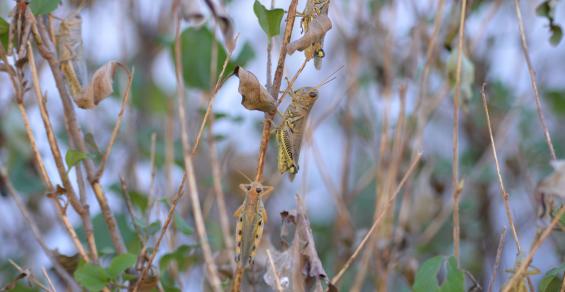In the drought years of the 1930s, farmers would half-jokingly say, “There are so many grasshoppers around that the chickens won’t even eat them anymore.” Fast-forward 90-plus years, and grasshoppers are still causing angst to farmers and ranchers.
There are about 100 different species of grasshoppers found in Nebraska, but only four of those normally damage crops: the two-striped, red-legged, differential and migratory grasshoppers. It has been reported in varied regions across the state since early to mid-July that large populations of immature hoppers were eating field borders.
Field border problem
Because grasshoppers generally do not like the dense plant canopies inside crop fields, damage is usually confined mostly to field borders and end rows. Border treatments of hopper infestations often help control populations from getting farther inside the field; and controlling threshold populations while the hoppers are still young and immature is much easier than when they become adults later in the summer. A border spray should be effective for at least seven to 14 days, depending on pressure for reinfestation. The residual activity of the treatments will vary with chemical and environmental conditions, so it remains important to monitor border areas and crop margins after treatment to make sure hoppers do not reenter the field. There may also be harvest and grazing restrictions when spraying borders, so reading and following label instructions is important.
Late summer
Once we get into late August and early September, control of adult grasshoppers is extremely difficult and in fact, not recommended, according to Nebraska Extension educator Wayne Ohnesorg. “Treatment is not recommended in September, as most of the grasshopper species will be adults” by that time, he says.
If the weather remains dry throughout the mid- to late-summer months, grasshoppers will continue to be an issue, but damage would be expected to decrease for adult hoppers compared to the nymphs, Ohnesorg says. That doesn’t mean the problem won’t reoccur next season. “Scouting next year in June for grasshopper nymphs will be important,” he adds. “With high populations now, there is great potential for egg laying this fall.”
While treatment decisions are generally based on the number of grasshoppers per square yard (See table) and the stage of the grasshoppers at the time of treatment, Ohnesorg says, “Unfortunately, September is just too late to control grasshoppers effectively. However, plans can be made for management the following growing season to maximize effectiveness.”
You can learn more about grasshoppers in Nebraska online at entomology.unl.edu/grasshoppers.
UNL CropWatch contributed to this article.
Grasshoppers have been a challenge across many parts of Nebraska this season, especially in those areas hit hardest by drought.




